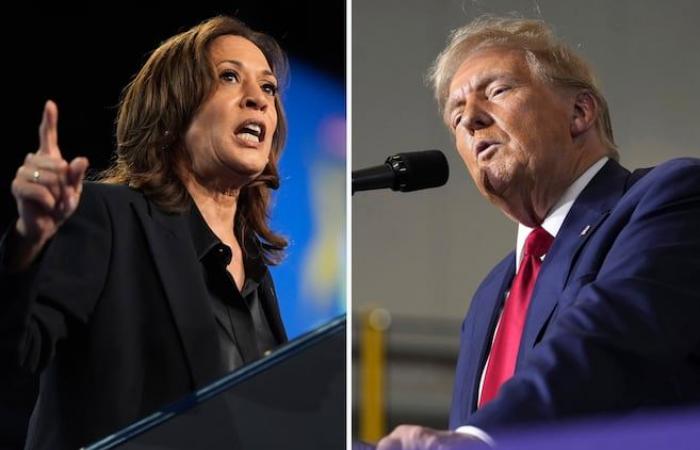It’s unlikely. But it’s not completely impossible.
This would mean that the polls of the last few weeks – let’s say even the last few months – will have been wrong. Pollsters give us Donald Trump and Kamala Harris tied nationally and almost cheek to cheek in the famous key states, those that will be ones to watch Tuesday evening when the ballots are counted.
Because we must make no mistake: it is not in Wyoming or Connecticut that the presidential election will be played out. We have been told for weeks that it will essentially be played out in seven states: Pennsylvania, Michigan, Wisconsin, North Carolina, Georgia, Arizona and Nevada. In all these states, there are margins of error and no one can predict who will win them.
Without going into the details of the electoral college which will confirm the victory of Kamala Harris or Donald Trump, let’s just say that each state has a certain number of electors, essentially based on their demographic weight. Pennsylvania, with its 19 electors, appears to be a key that could open the doors of the White House to one or other of the aspirants.
It is impossible, therefore, to look only at the polls in these key states because they themselves are even tighter than those for the country as a whole. Sometimes Trump is ahead by a point or two, sometimes it’s Harris.
But could it be that the polls are in the field and are underestimating the actual vote for one candidate or the other, resulting in a clear victory?
“It’s not impossible,” explains Francis Langlois, professor of history at Cégep de Trois-Rivières and associated researcher at the Observatory on the United States of the Raoul-Dandurand Chair (UQAM).
“It has often been said that Trump’s vote was undervalued, but it is possible that there could be a reversal. We have seen a change in the tide in recent days and Donald Trump’s erratic behavior has certainly not helped.”
— Francis Langlois, associate researcher at the Observatory on the United States of the Raoul-Dandurand Chair
And then there is this poll, which everyone has been talking about since the weekend, in Iowa. Until this poll, conducted by a firm led by one of the most credible pollsters, not everyone dared to place Iowa – with only six electors – in the fiercely contested battlegrounds. Trump enjoyed a lead of seven or eight percentage points in voting intentions.
But the Selzer & Co. survey conducted for the Des Moines Registergives Kamala Harris a three-point lead. It’s shocking. It’s surprising. We are looking for the causes of this surprise. Women’s vote? The vote of white, middle-class households? The rational vote of independent voters?
Experts agree, given the almost legendary reliability of Ann Selzer’s polls, that this poll could portend stronger results for the Democratic candidate in the Midwestern and Eastern states. Rust Belt.
Surprise is therefore not impossible. But the catch is that it can go one way or the other. The pro-Trump vote is possibly underestimated; he expresses anger and disillusionment with so-called traditional politicians and with institutions in general.
Francis Langlois is a member of the Observatory on the United States of the Raoul-Dandurand Research Chair and a professor at Cégep de Trois-Rivières. (STÉPHANE LESSARD/STÉPHANE LESSARD)
“This frustration within the population is reminiscent of that which we also observed at the end of the 1920s,” explains Francis Langlois. Angry voters wanted something radically different, and they sought it from the extremes of the political spectrum.
So if there are still today, among our neighbors to the south, frustrated, angry, disappointed, disenchanted or disillusioned voters, this does not mean that they will all find refuge in the extreme that Donald Trump proposes and embodies. .
“It’s surreal, what he embodies. I don’t know of a time in American history where a presidential candidate made it clear that he was going to be a dictator for a few days, hinted that he was going to go after some of his opponents, indicated that it wouldn’t be a big deal if journalists got shot, said of the Charlottesville riots that there were good people on both sides, tried to initiate a coup d’état… I could go on and on,” remarks Francis Langlois.
What risks making the difference on Tuesday evening is the vote of independent voters, that of soft or anti-Trump Republicans, and even more so that of women. If the issue of abortion materializes as the question at the ballot box as it was during the midterm elections in 2022, Trump could well be in a worse position than the polls suggest.
Francis Langlois points out that we do not know the percentage of independent voters who will lean for Kamala Harris. We also don’t know what proportion of Republicans who don’t want to see Trump as president will actually lean to the Democratic side and hold their noses.
“You should know that we always associate Democrats with the left, but I often say that Kamala Harris is as left-wing as François Legault can be. Economically, she is more to the right than many elected Democrats in the Senate or the House of Representatives,” notes the researcher. This could appeal to some Republicans who are not die-hard supporters of Donald Trump.
Also, it will be interesting to see how the teams of the two protagonists will succeed in getting the vote out. On the ground, the mobilization of Democrats seems more organized, more enthusiastic.
And there is the question of money. Between January 2023 and October 16, the campaign committee of Joe Biden, then Kamala Harris, raised more than $990 million, while Donald Trump’s campaign raised $388 million in total. This is not insignificant when the time comes, in particular, to buy air time for expensive advertisements in the states where everything will be at stake.
“We must not forget that Trump outsourced his financing. He may have fewer volunteers, but more mercenaries,” illustrates Francis Langlois, obviously referring to Elon Musk and other major donors of the same ilk.
And suppose, finally, that the nightmare that we have been predicted for months comes to fruition, that the election will be played out in a handful of key states and that protests and recounts will multiply, should we fear the worst?
“There is a risk that it will escalate. Maybe not as we saw in the film Civil Warreleased earlier this year, but it is certainly not for nothing that we are preparing to intervene in certain states if things get heated,” remarks Francis Langlois. If Kamala Haris wins, there will undoubtedly be voters with red caps who will challenge the validity of the election like their guru. Violence could break out and this could have impacts on the economy and social cohesion in the United States.
Clearly, if we thought we could end one nightmare, we might be preparing to live another one. From a distance, fortunately.






